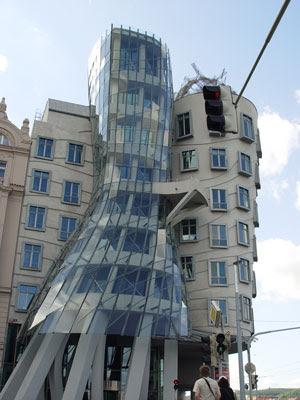There are some seriously cool buildings around the world. Look at these bizarre building pictures.
 The Dancing House
The Dancing House
Also nicknamed “The Drunk House”, is a downtown office building in Prague, in the Czech Republic, and was designed by Czech architect Frank Gehry. Notable features include a French restaurant on the roof, with wonderful views of the city.
 Golden Pyramid House
Golden Pyramid House
Wadsworth, Illinois. This odd structure is apparently a privately-owned residence, although at one time it may have been host to tours and even have operated a gift shop. However, these days the large front gate is forebodingly shut.
 Situated in Tokyo, Japan. Designed by Kisho Kurokawa, it is the world’s first example of capsule architecture, in which prefabricated modules/capsules were designed to be slotted into and around the main shaft of the building. Each capsule is able to function as an entirely separate office or living space, with capsules being able to connect to one another.
Situated in Tokyo, Japan. Designed by Kisho Kurokawa, it is the world’s first example of capsule architecture, in which prefabricated modules/capsules were designed to be slotted into and around the main shaft of the building. Each capsule is able to function as an entirely separate office or living space, with capsules being able to connect to one another.
 Habitat 67
Habitat 67
Situated in Montreal, Canada. This was created by architect Moshe Safdie, and was supposed to give the illusion of many different private/separate houses, but with the economic practicality of modern-day apartment complex construction. Another example of “modular” architecture, the aim was to use interlocking concrete “modules” in order to create affordable and stylish private housing. Ironically, due to the architectural fame of Habitat 67, the units are nowadays quite expensive.
 The Robot Building
The Robot Building
Located in the Sathorn district of Bangkok, Thailand. This strange construction actually houses the United Overseas Bank’s Bangkok headquarters. Designed by architect Sumet Jumsai to emphasize the increasing usage of computers in modern-day banking.
 The Crooked House
The Crooked House
Located in Sopot, Poland. Inspired by various fairytale drawings and built by Polish architects Szotyńscy Zaleski, this strange-looking building actually houses a multitude of bars, cafes, and shops. However, I imagine most of the visual appeal is offered from the outside, rather than within.
 The Longaberger Company/The Basket Building
The Longaberger Company/The Basket Building
This building in Ohio is home to the headquarters of a top American basket manufacturer, and is built to resemble one of their best-selling products, a basket. Originally, the founder – Dave Longaberger – wanted each company building to be basket-shaped, however his wishes we not to be granted, as after his death, his daughters vetoed plans to build more basket buildings.
 Steel House
Steel House
Designed and built by artist Robert Bruno, and situated in Lubbock, Texas. Born from an idea that Bruno had upon completing a steel sculpture, he wondered what it would be like if he could walk through it. Weighing in at 110 tons of steel, it was constructed by welding steel plates onto a pre-built dome-like centre structure.
 Ripley’s Believe It Or Not Building
Ripley’s Believe It Or Not Building
Branson, Missouri. In order to reflect the 8.0 scale earthquake that happened at New Madrid, MO in 1812, this was purposely built so that it looked like it had barely made it through that earthquake. It’s currently home to the Branson outlet of the Ripley’s Believe It Or Not museums.
 The Mushroom/Tree house
The Mushroom/Tree house
Designed by architect – and also professor of Architecture at the University of Cincinnati – Terry Brown. Brown was also helped with its construction by his university students, as part of an ongoing project. In 2006, it was announced that the house was for sale for roughly $400,000.
Not sure what the home insurance price would cost on these buildings!
 The Dancing House
The Dancing HouseAlso nicknamed “The Drunk House”, is a downtown office building in Prague, in the Czech Republic, and was designed by Czech architect Frank Gehry. Notable features include a French restaurant on the roof, with wonderful views of the city.
 Golden Pyramid House
Golden Pyramid HouseWadsworth, Illinois. This odd structure is apparently a privately-owned residence, although at one time it may have been host to tours and even have operated a gift shop. However, these days the large front gate is forebodingly shut.
 Situated in Tokyo, Japan. Designed by Kisho Kurokawa, it is the world’s first example of capsule architecture, in which prefabricated modules/capsules were designed to be slotted into and around the main shaft of the building. Each capsule is able to function as an entirely separate office or living space, with capsules being able to connect to one another.
Situated in Tokyo, Japan. Designed by Kisho Kurokawa, it is the world’s first example of capsule architecture, in which prefabricated modules/capsules were designed to be slotted into and around the main shaft of the building. Each capsule is able to function as an entirely separate office or living space, with capsules being able to connect to one another. Habitat 67
Habitat 67Situated in Montreal, Canada. This was created by architect Moshe Safdie, and was supposed to give the illusion of many different private/separate houses, but with the economic practicality of modern-day apartment complex construction. Another example of “modular” architecture, the aim was to use interlocking concrete “modules” in order to create affordable and stylish private housing. Ironically, due to the architectural fame of Habitat 67, the units are nowadays quite expensive.
 The Robot Building
The Robot BuildingLocated in the Sathorn district of Bangkok, Thailand. This strange construction actually houses the United Overseas Bank’s Bangkok headquarters. Designed by architect Sumet Jumsai to emphasize the increasing usage of computers in modern-day banking.
 The Crooked House
The Crooked HouseLocated in Sopot, Poland. Inspired by various fairytale drawings and built by Polish architects Szotyńscy Zaleski, this strange-looking building actually houses a multitude of bars, cafes, and shops. However, I imagine most of the visual appeal is offered from the outside, rather than within.
 The Longaberger Company/The Basket Building
The Longaberger Company/The Basket BuildingThis building in Ohio is home to the headquarters of a top American basket manufacturer, and is built to resemble one of their best-selling products, a basket. Originally, the founder – Dave Longaberger – wanted each company building to be basket-shaped, however his wishes we not to be granted, as after his death, his daughters vetoed plans to build more basket buildings.
 Steel House
Steel HouseDesigned and built by artist Robert Bruno, and situated in Lubbock, Texas. Born from an idea that Bruno had upon completing a steel sculpture, he wondered what it would be like if he could walk through it. Weighing in at 110 tons of steel, it was constructed by welding steel plates onto a pre-built dome-like centre structure.
 Ripley’s Believe It Or Not Building
Ripley’s Believe It Or Not BuildingBranson, Missouri. In order to reflect the 8.0 scale earthquake that happened at New Madrid, MO in 1812, this was purposely built so that it looked like it had barely made it through that earthquake. It’s currently home to the Branson outlet of the Ripley’s Believe It Or Not museums.
 The Mushroom/Tree house
The Mushroom/Tree houseDesigned by architect – and also professor of Architecture at the University of Cincinnati – Terry Brown. Brown was also helped with its construction by his university students, as part of an ongoing project. In 2006, it was announced that the house was for sale for roughly $400,000.
Not sure what the home insurance price would cost on these buildings!

Comments
0 Response to '10 Very Cool Buildings'
Post a Comment